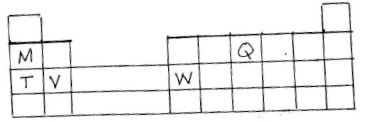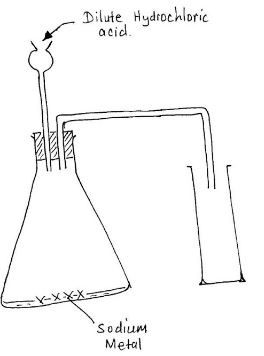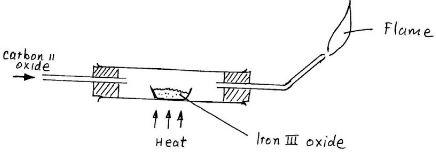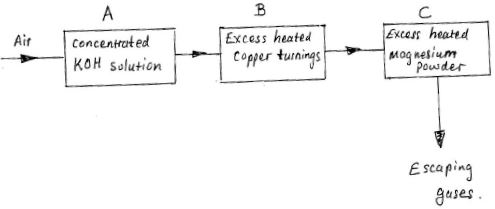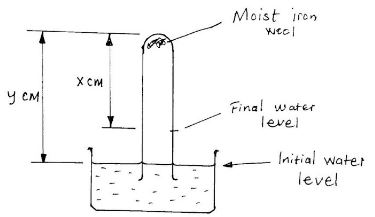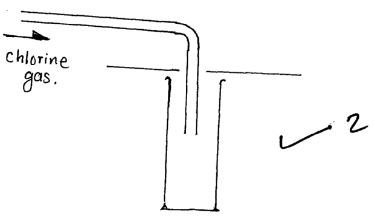INSTRUCTIONS:
- Answer all questions in the space provided.
- The diagram below represents part of the periodic table use it to answer the questions that follow.
- Write the electronic management for the stable ion formed by W (1mk)
- Write the question for the reaction between V and Q ( 1 mk)
- How do we ionization energies of the elements M and T compare. Explain (2mks)
- 60cm3 of oxygen diffuses through a porous pot in 50 seconds. How long would it take 60cm3 of oxygen gas diffuses through a porous pot in 50sec.How long would it take 60cm3 of Sulphur (iv) oxide to diffuse through the same pot under the same conditions? (4mks)
- Give 2 reasons why helium is used in weathers baloons (2mks)
- State the types of change that take place in each of the following situations
- Burning a piece of charcoal (1mk)
- Heating copper (ii) carbonate strongly (1mk)
- Heating Zinc oxide strongly (1mk)
- In a experiment to determine the percentage of purity of a sample of sodium carbonate, 2.15g of the sample reacted completely with 40cm3 of 0.5m sulphuric (iv) acid
- Calculate the number of moles of Sodium Carbonate that reacted (2mks)
- Determine the percentage of Sodium Carbonate in the sample (Na=23,C=12,0=16 (3MK)
- Name two industrial uses of Sodium Carbonate (2mks)
- A certain mass of gas occupies 0.15dm3 at 20°c and 98,648.5pa, Calculate it volume at 101325pa and 0°c (3mks)
-
- Explain why aluminum is a better conductor of electricity than Sodium (2mks)
- State one property of aluminum that makes it suitable for power transmission cables (1mk)
- The diagram below shows set-up for preparing hydrogen gas by a Form 3 Student.
- Identify three mistakes with the set-up (3mks)
- On the diagram make suitable modification to solve the mistakes in( a) above (3mks)
- What is the test for hydrogen gas (1mk)
- Carbon Monoxide gas was passed over heated iron III Oxide as shown in the diagram below
- Give the observation made in the combustion tube (1mk)
- Write the equations for the reaction which take place in the combustion tube (1mk)
- Which property of carbon II Oxide are demonstrated by the experiment (1mk)
- State and explain the function of tartaric acid in baking powder (2mks)
-
- State Boyle’s Law (1mk)
- 300cm3 of a gas at 800mm Hg was compressed to 200mm Hg pressure at constant temperature. Determine the new volume (2mks)
- Explain why it is not suitable to have a
- Jiko with burning charcoal in a closed room (2mks)
- Which gas is contained in tizzy drinks? 1mk)
- Write an equation for the reactions on the gas contained in dizzy drink and water (1mk)
- Air was passed through several reagents as shown in the flow chart below
- Identify substances removed from chambers A and B then
- Write an equation for the reaction which take place in the chamber with magnesium powder (1mk)
- Name one gas which escapes from the chamber containing heated magnesium powder.
Give a reason for your answer (2mks)
Gas
Reason
- When potassium Nitrate is heated, it produces potassium Nitrate and gas X
- Identify gas X (1mk)
- Name the type of reaction undergone by the potassium Nitrate (1mk)
- Write a balanced equation for the reaction between Magnesium and Steam (1mk)
- When Chlorine gas was bubbled through water the resulting solution act as a bleaching agent
- Explain how the resulting solution act as a bleaching agent (2mks)
- Using a neat diagram show how chlorine gas is collected in the laboratory (2mks)
- Study the information in the table below and answer the questions that follow: The letters do not represent the actual symbol of the element).
Element Electronic configuration Ionisation energy KJ mol−1 P
Q
R2,1
2,8,1
2,8,8,1519
494
418- What is the general name given to the group in which element P, Q and R belong? (1mk)
- What is meant by ionisation energy (1mk)
- Explain why Element P has the highest ionisation energy (2mk)
- When a piece of element Q is placed on water it melts and a hissing sound is produced as it moves on the surface of the water .Explain this observation (3mks)
- Write an equation for the reaction between elements Q and water (1mk)
- Some moist iron wool was placed in a test tube and the tube inverted and placed in a beaker containing water. The apparatus was left for one week .It was observed that the iron wool had rusted and the water level had raisen.No further change took place when the set-up was left for more days even though not all the iron rusted.
- Explain whether rusting is a chemical or a physical change (2mks)
- Write an expression for an approximate percentage of air used up (1mk)
- What would be the effect on the level of the water if a larger piece of iron wool was used (2mk)
- State the similarities between rusting and combustion (2mks)
- The table below gives the number of protons and neutrons in element G,H,I and J.
Element G H I J Number of protons 3 17 19 19 Number of neutrons 4 20 18 22 - Which atoms isotopes of the same element? (2mks)
- Which atoms have the same mass number (2mks)
- Write formula of the compound formed between G and H (1mk)
- Give the valency of each of the elements (1mk)
or radical in the following chemical compounds. (3mks)- Ca3(PO4)2
- Mg3N2
- NaOH

Marking Scheme
- The diagram below represents part of the periodic table use it to answer the questions that follow.
- Write the electronic management for the stable ion formed by W (1mk)
2,8 - Write the question for the reaction between V and Q ( 1 mk)
3V(s) +Q2(g) → V3Q2(s) - How do we ionization energies of the elements M and T compare. Explain (2mks)
- M has a higher ionisation energy than T since the outer electrons in M are closer to the nucleus hence held more strongly.
- Write the electronic management for the stable ion formed by W (1mk)
- 60cm3 of oxygen diffuses through a porous pot in 50 seconds. How long would it take 60cm3 of oxygen gas diffuses through a porous pot in 50sec.How long would it take 60cm3 of Sulphur (iv) oxide to diffuse through the same pot under the same conditions? (4mks)
M(SO)g =32+16×2
=64
MO =16 × 2
=32
=50 × √2
=70.7seconds - Give 2 reasons why helium is used in weathers baloons (2mks)
- Light
- Inert
- State the types of change that take place in each of the following situations
- Burning a piece of charcoal (1mk)
- Permanent change
- Heating copper (ii) carbonate strongly (1mk)
- Permanent change
- Heating Zinc oxide strongly (1mk)
- Temporary change
- Burning a piece of charcoal (1mk)
- In a experiment to determine the percentage of purity of a sample of sodium carbonate, 2.15g of the sample reacted completely with 40cm3 of 0.5m sulphuric (iv) acid
- Calculate the number of moles of Sodium Carbonate that reacted (2mks)
Moles of H2SO4 that reacted = 40/100 × 0.5 =0.02
Moles of Na2CO3 that reacted =0.02
Mole ratio Na2CO3: H2SO4 1:1 - Determine the percentage of Sodium Carbonate in the sample (Na=23,C=12,0=16 (3MK)
Mass=Moles × FM
=0.02 ×106
=2.12g
Percentage of purity = 2.12 ×100
2.15
=98.6% - Name two industrial uses of Sodium Carbonate (2mks)
- Water softening
- Manufacture of glass
- making of soap
- Making of sodium hydrogen Carbonate-baking Powder
- Calculate the number of moles of Sodium Carbonate that reacted (2mks)
- A certain mass of gas occupies 0.15dm3 at 20°c and 98,648.5pa, Calculate it volume at 101325pa and 0°c (3mks)
T1 = 20°c =293K
T2 = 0°c =273K
P1V1 = P2V2
T1 T2
V2 = 98648.5 × 0.15 × 273
293 × 101325
=0.136dm3 -
- Explain why aluminum is a better conductor of electricity than Sodium (2mks)
- Aluminium has three valency electrons and sodium only one. Aluminium has more electricity carriers.
- State one property of aluminum that makes it suitable for power transmission cables (1mk)
- Low density// light
- Explain why aluminum is a better conductor of electricity than Sodium (2mks)
- The diagram below shows set-up for preparing hydrogen gas by a Form 3 Student.
- Identify three mistakes with the set-up (3mks)
- Thistle funnel too short
- Use of sodium metal.
- Wrong gas collection method.
- On the diagram make suitable modification to solve the mistakes in( a) above (3mks)
- What is the test for hydrogen gas (1mk)
- Burns with a pop sound
- Identify three mistakes with the set-up (3mks)
- Carbon Monoxide gas was passed over heated iron III Oxide as shown in the diagram below
- Give the observation made in the combustion tube (1mk)
- Solid changes from brown to grey.
- Write the equations for the reaction which take place in the combustion tube (1mk)
- Fe2O3(s) + 3CO(g) → 2Fe(s) + 3CO2(g)
- Which property of carbon II Oxide are demonstrated by the experiment (1mk)
- Reducing agent.
- Give the observation made in the combustion tube (1mk)
- State and explain the function of tartaric acid in baking powder (2mks)
- Tartaric acid attacks (reacts) with sodium hydrogen carbonate producing carbon (IV) oxide gas which escapes through the dough creating passages through which hot cooking oil rises.
CO2 gas causes the dough to rise
- Tartaric acid attacks (reacts) with sodium hydrogen carbonate producing carbon (IV) oxide gas which escapes through the dough creating passages through which hot cooking oil rises.
-
- State Boyle’s Law (1mk)
- The volume of a fixed mass of a gas is inversely proportional to its pressure provided the temperature remains constant.
- 300cm3 of a gas at 800mm Hg was compressed to 200mm Hg pressure at constant temperature. Determine the new volume (2mks)
P1V1 =P2V2
V2 = 800 × 300
200
=1200cm3
- State Boyle’s Law (1mk)
- Explain why it is not suitable to have a
- Jiko with burning charcoal in a closed room (2mks)
- Oxygen in the room will be insufficient resulting to formation of CO gas which is poisonous.
- Which gas is contained in tizzy drinks? 1mk)
- Carbon (IV) Oxide
- Write an equation for the reactions on the gas contained in dizzy drink and water (1mk)
H2O(l) + CO2(g) → H2CO3(aq)
- Jiko with burning charcoal in a closed room (2mks)
- Air was passed through several reagents as shown in the flow chart below
- Identify substances removed from chambers A and B then
- A- Carbon (IV) Oxide
- B-Oxygen
- Write an equation for the reaction which take place in the chamber with magnesium powder (1mk)
3Mg(s) + N2(g) → Mg3N2(s) - Name one gas which escapes from the chamber containing heated magnesium powder.
Give a reason for your answer (2mks)
- Gas-Neon or Helium
- Reason-The gas is inert
- Identify substances removed from chambers A and B then
- When potassium Nitrate is heated, it produces potassium Nitrate and gas X
- Identify gas X (1mk)
2KNO3(s)2KNO2(s) +O2(g)
Oxygen gas - Name the type of reaction undergone by the potassium Nitrate (1mk)
- Thermo decomposition
- Identify gas X (1mk)
- Write a balanced equation for the reaction between Magnesium and Steam (1mk)
Mg(s) + H2O(g) → MgO(s) +H2(g) - When Chlorine gas was bubbled through water the resulting solution act as a bleaching agent
- Explain how the resulting solution act as a bleaching agent (2mks)
- The gas dissolves in water forming HCl and HOCl. HOCl being unstable decomposes forming HCl and Oxygen free radical that attach // combine with pigment which looses colour.
- Using a neat diagram show how chlorine gas is collected in the laboratory (2mks)
- Explain how the resulting solution act as a bleaching agent (2mks)
- Study the information in the table below and answer the questions that follow: The letters do not represent the actual symbol of the element).
Element Electronic configuration Ionisation energy KJ mol−1 P
Q
R2,1
2,8,1
2,8,8,1519
494
418- What is the general name given to the group in which element P, Q and R belong? (1mk)
- Alkali metals
- What is meant by ionisation energy (1mk)
- Energy required to remove an electron from an atom or molecule.
- Explain why Element P has the highest ionisation energy (2mk)
- P has the smallest atomic radius and therefore the valency electron is most strongly attracted to the nucleus.
- When a piece of element Q is placed on water it melts and a hissing sound is produced as it moves on the surface of the water .Explain this observation (3mks)
- Melts due to heat produced in the reaction.
- Hissing sound due to the production of hydrogen.
- Floats on water, sodium is less dense than water.
- Write an equation for the reaction between elements Q and water (1mk)
2Q(s) + 2H2O(l) → 2QOH(aq) + H2(g)
or
2Na(s) + 2H2O(l) → 2NaOH(aq) + H2(g)
- What is the general name given to the group in which element P, Q and R belong? (1mk)
- Some moist iron wool was placed in a test tube and the tube inverted and placed in a beaker containing water. The apparatus was left for one week .It was observed that the iron wool had rusted and the water level had raisen.No further change took place when the set-up was left for more days even though not all the iron rusted.
- Explain whether rusting is a chemical or a physical change (2mks)
- Chemical change- a new substance is formed
- Write an expression for an approximate percentage of air used up (1mk)
y − x × 100%
y - What would be the effect on the level of the water if a larger piece of iron wool was used (2mk)
- No effect-volume of oxygen in the test-tube remains the same.
- State the similarities between rusting and combustion (2mks)
- Oxygen is used
- Both from oxides
- Mass increases in both cases
- Explain whether rusting is a chemical or a physical change (2mks)
- The table below gives the number of protons and neutrons in element G,H,I and J.
Element G H I J Number of protons 3 17 19 19 Number of neutrons 4 20 18 22 - Which atoms isotopes of the same element? (2mks)
- I and J
- Which atoms have the same mass number (2mks)
- H and I
- Write formula of the compound formed between G and H (1mk)
2G(s) + H2(g) → 2GH(g)
Or
2Li(s) + Cl2(g) → 2LiCl(s)
- Which atoms isotopes of the same element? (2mks)
- Give the valency of each of the elements (1mk)
or radical in the following chemical compounds. (3mks)- Ca - 2 (PO4)−3 - 3
- Mg -2 N - 3
- Na -1 OH-1
- Ca - 2 (PO4)−3 - 3
Join our whatsapp group for latest updates
Tap Here to Download for 50/-
Get on WhatsApp for 50/-
Download Chemistry Paper 2 Questions and Answers - Form 3 Mid Term 1 Exams 2021.
Tap Here to Download for 50/-
Get on WhatsApp for 50/-
Why download?
- ✔ To read offline at any time.
- ✔ To Print at your convenience
- ✔ Share Easily with Friends / Students

